Visual Storytelling Using Subtext
What is Subext?
Subtext can be defined as the implicit meaning of a text – it’s the underlying message that is not explicitly stated, or shown in a movie or short film. Subtext gives the reader or viewer information about characters, plot, and the story’s context as a whole.
In this post I’m going to give you examples of how I visually used subtext in two of my short films to reinforce the story I was telling, starting with how I used it with the Rule of Thirds.
The rule of thirds is one of the most well-known compositional rules in photography and filmmaking, and it’s one of the first things you should learn when you pick up a camera. But just because it’s a “rule” that doesn’t necessarily mean you ‘have to’ follow it. Sometimes breaking that rule is a good thing, especially when you want to add subtext to the scene.
First, let’s take a look at what it is so you’ll have a better understanding of when to use it, and when to break it.
What is the Rule of Thirds?
The “Rule of Thirds” is the basic compositional structure of the image. Visually, you split it into 9 equal segments by using 2 vertical and 2 horizontal lines, as depicted in the image below.
The rule, which is really more of a guideline than an actual rule, suggests that you should place the image’s main point of interest on one of the 4 spots (the blue circle) where the lines intersect, or at the very least, the key visual element of your scene is positioned on one of the vertical or horizontal lines.
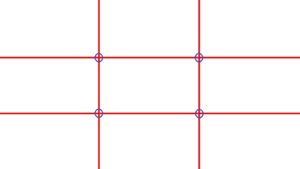
When it comes to framing a single actor in your shot, you typically place the eye that is closest to the camera on or near where the lines intersect.
The rule also states that the most visually appealing view is placing the actor’s body on one of the vertical lines and having them look towards the other vertical line. This provides enough empty “space” for the person to “look into.”
In the two screenshots below, taken from my short film Unscheduled Visit, I followed the Rule of Thirds.
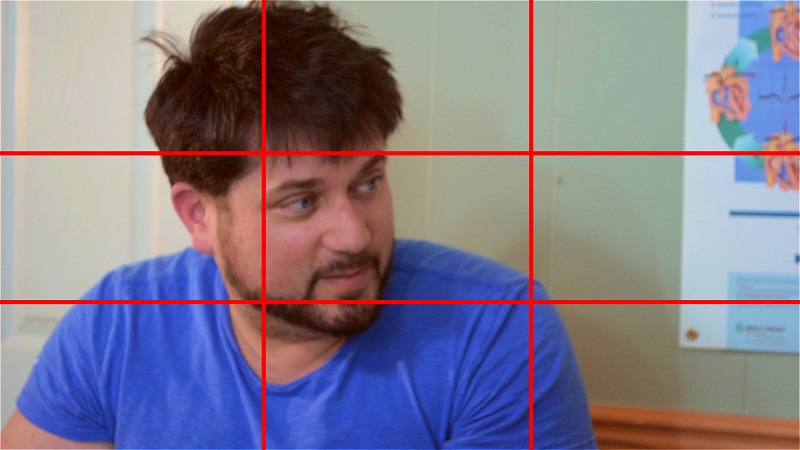
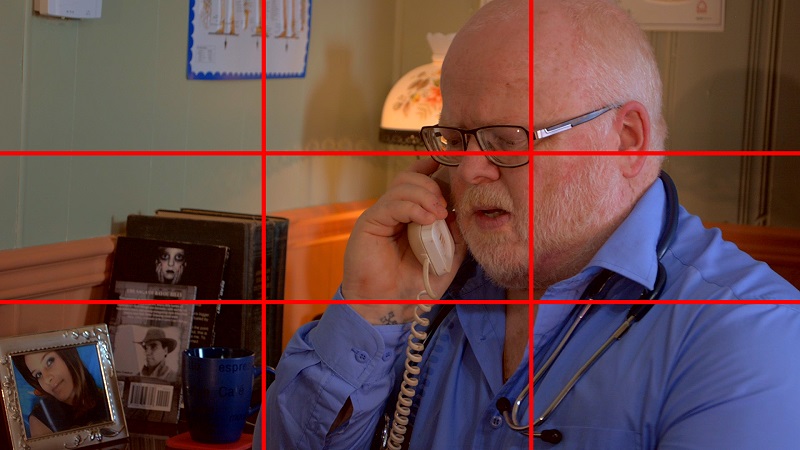
In the first image, “Scott” (played by Chad Bryden) is placed along the left vertical line and is looking towards the other vertical line. That is, he is looking camera right. The eye that is physically closest to the camera is not directly on the intersecting lines, but it is fairly close which is close enough. Notice how the vertical line pretty much divides the actor into two equal parts.
In the second screenshot, the Docter (played by Michael G. MacDonald) is placed along the right vertical line because he is looking camera left. His eye is also very near the intersecting lines but not exactly, and the vertical line also runs down the middle of the actor.
It’s important to remember that even though the rule states that their eye “should” be on the intersecting lines, this is filmmaking and not still photography… the actors do move during the scene and it would be virtually impossible to keep their eye exactly on the intersection for the entire scene. Plus, there’s a lot more that goes into good framing and shot composition than just the placement of the person’s eye.
By using the Rule of Thirds, both characters have plenty of “empty space” to look into. This is what we as viewers typically consider to be the most visually appealing. To put it another way, this could be considered a “normal” view, and it is one that filmmakers use quite frequently.
Now let's talk about visually using subtext to reinforce the scene
In the two screenshots below, taken from my short film, The Interrogation starring Darren Andrea, I broke the rule of thirds. He is still on the vertical line, but when he is looking right I have him on the right vertical line instead of the left, and when he is looking left, I have him on the left vertical line instead of the right where he “should be” if I followed the Rule of Thirds.
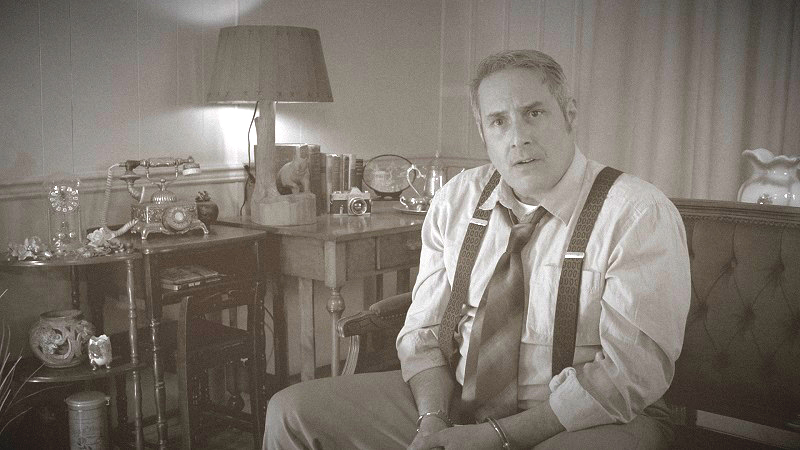
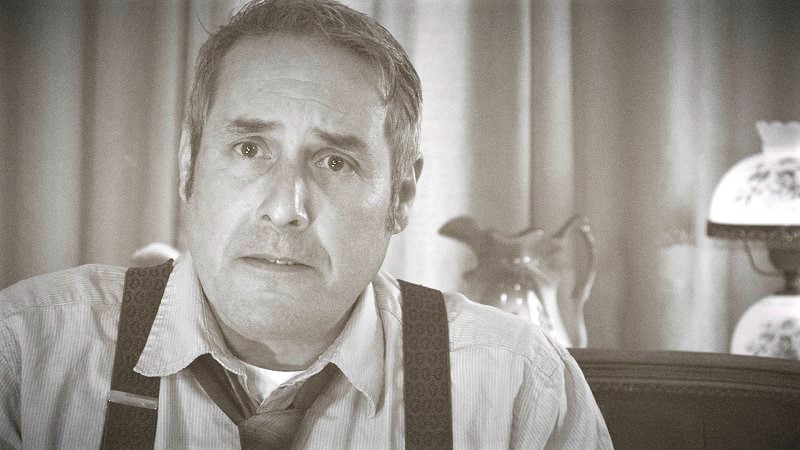
Those two images are the exact opposite of what we consider to be a “normal” view using the Rule of Thirds, so why did I frame the shots this way?
Because I wanted to visually tell the audience that despite what you see and hear the actor saying, something is “off” with him; something isn’t quite right.
The subtext is subtle and something most people won’t even notice, but the feeling it leaves you with helps reinforce the story by visually telling the audience that something isn’t quite right.
The Key to Subtext is Subtlety.
If I highlighted the fact that there’s something off about this guy it would ruin the ending and the story as a whole. The subtext is not meant to be a flashing neon sign to make sure the audience “gets it” – it’s only supposed to create the necessary feelings needed to help reinforce the story.
Watch the video below to see how I visually used subtext by breaking the Rule of Thirds to reinforce the story.
Method #2 of Visually Using Subtext to Reinforce the Story
To get the most out of this section, it is best if you first watch the short film, UNSCHEDULED VISIT, and then continue reading.
Unlike the last example where I placed the actor on the “wrong” vertical line to show that something was off, in Unscheduled Visit I used a different technique to reinforce the story being told.
When you first watched the film you probably didn’t even notice what I did to visually add subtext – you weren’t supposed to – but how I filmed the various sections of each scene was designed to make you feel something that made the story that much more believable.
Remember, the key is subtlety, not big, bold gestures. Okay, let’s break it down…
One of the first things you’ll notice is I broke another “Rule” in filmmaking because the two main actors are rarely seen on screen together. Most filmmakers use either over-the-shoulder shots or a two-shot to show both actors, but for the most part, the majority of their scenes are “singles’ (Only one actor is seen at a time.) I did this for a very specific reason – to set up the visual subtext…
The doctor is a confident man; he’s “rock solid” in his attitude and knows exactly what is going on. To reinforce this, the singles of him were filmed with the camera “locked down” on a tripod. There is no camera movement at all.
Conversely, “Chad” is having a rough time. He’s confused and not sure what to do or say. To reinforce the chaos Chad is feeling, I filmed his singles handheld. That is, I didn’t use a tripod so there is some slight movement. It’s worth noting that I didn’t “add” movement or shake the camera – it is very difficult to hold a camera perfectly still, and that added more than enough movement without making it look too jarring.
But then I took it a step farther…
Once Chad gets everything off his chest and says what he wanted to say, he is now at peace. To reinforce the calm he was feeling, I shot the remainder of his singles with the camera locked down on a tripod.
Chad’s “calm” also means the doctor’s reality was suddenly thrown into chaos because he just learned that he was talking to a ghost. To reinforce that feeling of chaos, the remainder of the doctor’s singles were shot handheld.
To quickly recap what I did… when the character was calm, the shots were locked down on the tripod so there was no camera movement at all. When the character was feeling uneasy, it was a handheld shot that naturally added small, subtle camera movements to reinforce that feeling.
There’s another more place where I used subtext to reinforce the story…
When the nurse (played by Ida Donovan) enters the doctor’s office, at no point does she ever look at Chad, she looks directly at the doctor. To reinforce this, I sat in the doctor’s chair and had her look directly into the camera (something else that actors are not supposed to do.)
I also added a quick scene of her looking somewhat confused and asking the doctor if everything is okay. At first, that might not have made a lot of sense, but when you get to the end of the story and learn that Chad is a ghost, it suddenly makes sense… she’s asked the doctor if everything is okay because when he made comments such as “we both have work to do” etc., to her it looked like the doctor was talking to himself because he was the only one who could actually see Chad’s ghost.
It is also why I had Chad walk into the office unannounced while the nurse is seen in the background helping a patient fill out paperwork, then a little later in the story, the nurse comes into the office to tell the doctor his next patient is ready.
By themselves, these little scenes don’t really seem to have anything to do with the main story, but they were put there for a very specific reason… to reinforce the fact that the doctor really was talking to a ghost.
It is the little things that add so much to a story. And, because they are little and seem unimportant, most people don’t even notice them. But, if I filmed this story without those seemingly unimportant scenes, the story would fall flat because there was no subtext to reinforce the main scenes.
Everything that you write in a screenplay and everything you film should have a reason for being there. If it doesn’t have a reason, it shouldn’t be in your story and it shouldn’t be in your film.
Okay Kenn, that makes sense but… what about the very first patient, she had nothing to do with the story? Isn’t her scene just filler?
Nope. Kendra (played by Caitie MacQuarrie) was put there to introduce the doctor and show how friendly and caring he is towards his patients. That way, when he speaks to Chad in a terse and not so friendly manner, you know Chad did something wrong and the doctor is not happy with him.
Everything must have a reason to be in your story. If it doesn’t, it’s dead weight that will slow down the story and bore your audience.
I hope you enjoyed this post. If you have any questions or comments, please post them below and I’ll get back to you as soon as possible. Thank you.
Now go film something amazing!
No Comments